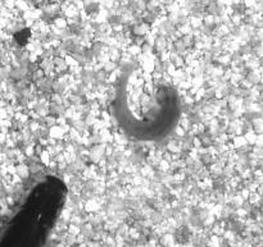FISH ESCAPE RESPONSES
The ability to avoid and escape from predators is critical to the survival of organisms, and can be accomplished through a variety of ways. Some organisms rely on crypsis, others use refugia, and others rely on the ability to perform fast-start escape responses. Most fishes use a behavior called a C-start escape response, which involves the unilateral contraction of the axial musculature in the opposite direction of the stimulus (e.g., predator), bending the body into a "C" shape, and is then followed by a contralateral contraction of the musculature on the other side of the body. Yet, recent work in the past several years has documented that escape responses are far from stereotypical and can be quite context-dependent (read Paolo Domenici's 2011 JEZ paper for a great review!). Given that performance is often linked to morphology (via the morphology-performance-fitness paradigm described by Arnold 1983), such variation in escape responses can be a conduit for generating substantial phenotypic and functional diversity. See below for some of the research projects that I have been involved in to explore the context-dependency of fish escape responses!
Foraging behavior delays mechanically-stimulated escape responses in fish

Animals may get attacked while they are foraging, and face the dilemma of fleeing but losing their food resources or stay and feed but risk being eaten ("feed-or-flee" dilemma; Ydenberg and Dill 1986). Previous work has found that animals sometimes experience decreased diligence while feeding, which could put them at risk by impeding their ability to detect an oncoming predator attack. To evaluate this, I collaborated with Jimena Bohórquez-Herrera and Paolo Domenici while attending the Fish Swimming Class at Friday Harbor Laboratories in 2009. We tested silver-spotted sculpins (Blepsias cirrhosus) in three conditions: standard escape response with no food (control), escape response while chasing a prey item, and escape response after successfully capturing the chased prey. Although we did not find evidence for kinematic differences between these experimental groups, we did find that foraging can decrease the tendency to perform an escape response, and can increase the time it takes to respond to a stimulus (e.g., predator). These findings suggest that foraging can have a negative impact on the ability of fish to respond to a threat.
Read more in our 2013 ICB paper: Bohórquez-Herrera et al. (2013)!
Photo is a snapshot of Blepsias cirrhosus performing a C-start escape response following the "attack" of a mechanical predator (i.e., weight being dropped into the water). Hey, that's pretty scary for a little fish! Photo was extracted from data presented in Bohórquez-Herrera et al. (2013).
Read more in our 2013 ICB paper: Bohórquez-Herrera et al. (2013)!
Photo is a snapshot of Blepsias cirrhosus performing a C-start escape response following the "attack" of a mechanical predator (i.e., weight being dropped into the water). Hey, that's pretty scary for a little fish! Photo was extracted from data presented in Bohórquez-Herrera et al. (2013).
Effects of refugia on fish escape responses

Many studies on escape responses are conducted in laboratory conditions within standard aquaria (e.g., empty enclosures with smooth sides). We have learned a tremendous amount from such studies, but there is also interest in understanding how animals can exploit aspects of their environment to facilitate their escape responses. For instance, animals may wait longer before escaping because they can flee into a hole or bury themselves, taking them out of the reach of predators. Thus, reliance on refugia can allow prey to take greater risks by staying out longer or let them get away with slower escapes. To investigate how refugia can influence escape responses, I studied the Hawaiian goby fish, Stenogobius hawaiiensis, which is an amphidromous fish that lives in the estuarine regions of the Hawaiian islands. S. hawaiiensis is particularly appropriate because it lives in an area saturated with the piscivorous predator Eleotris sandwicensis, and buries itself in sand and flees under rocks when threatened (Kawano pers. obs.). I tested juvenile S. hawaiiensis in control conditions (e.g., flat, white bottom tank) and experimental conditions (sand bottom with rocks to hide under), and stimulated fish with a plastic fish that attacked individual S. hawaiiensis at a speed comparable to that of an attacking sculpin fish. I digitized the S. hawaiiensis with DLTdv3 (Hedrick 2008) and categorized the escape response based on what the fish did after escaping (e.g., burying itself in sand, hiding under rock, swimming out into the open). Although I'm still working on analyzing these data, preliminary results indicate that fish that had refugia present would allow the stimulus (i.e., attacking plastic fish) to approach closer. This work was conducted in collaboration with Heiko Schoenfuss (St. Cloud State University) and Rick Blob (Clemson University).
Photo is a snapshot from one of the high-speed videos I collected with a S. hawaiiensis (middle) performing a C-start escape in response to the plastic predator (bottom left).
Stay tuned for more!
Photo is a snapshot from one of the high-speed videos I collected with a S. hawaiiensis (middle) performing a C-start escape in response to the plastic predator (bottom left).
Stay tuned for more!
